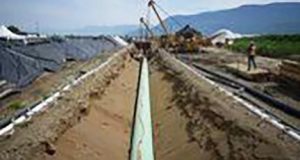By Patrick Quinn
Local Journalism Initiative
The Cree Regional Climate Forum brought together a diversity of voices in Ouje-Bougoumou to understand and plan for the repercussions of a rapidly warming planet.
The forum recognized the urgency of action in the wake of unprecedented forest fires and the warmest year on record. The Cree Nation Government’s Climate Change unit hopes to make this an annual event to develop Cree-led climate strategies.
“There’s no boundaries to climate change,” said CNG climate change manager Olivier Kölmel. “It goes beyond the region so broader collaboration is needed for the future of the communities. The big work is yet to come, but it’s exciting work.”
About 150 participants came from most Cree communities, along with some First Nations in Ontario and selected representatives from provincial and federal governments and academia. The forum’s three themes were community engagement, adaptation planning and climate leadership.
The day after a spectacular solar eclipse, the conference began by taking stock of recent climate impacts and current mitigation initiatives. Last summer’s wildfires sought to redefine the Cree relationship with Eeyou Istchee’s forests.
“Climate adaptation asks Cree Nation members to change their way of living because of the environment,” Grand Chief Mandy Gull-Masty said in her keynote speech.
“Regeneration is not just one season but sometimes decades. The risk is incredibly high for the upcoming fire season.”
With fires impacting 60% of traplines and forcing many communities to evacuate, Gull-Masty emphasized that the climate had made them refugees. The province was vastly unprepared for the extent of damage. Gull-Masty said a province-wide approach would better support First Nations safety and potential displacements.
Besides loss of wildlife and long-term effects on land and water, fires resulted in emissions equivalent to 140 million vehicles running year-round. While the hazardous smoke reaching New York City made international headlines, the Cree Nation will be releasing a documentary next month to illustrate its aftermath in Eeyou Istchee.
“There’s a realization everything is intertwined,” said Kölmel. “You may be breathing in smoke a day or two, but the communities had it for months. We went north of Waswanipi by the Broadback to film the impacts and the camps and cabins lost.”
Deputy Grand Chief Norman Wapachee moderated the forum’s forest fire panel featuring CNG fire marshal Lee-Roy Blacksmith, Thomas Stevens of the Cree Trappers’ Association and federal and provincial representatives. Among proposed solutions was making better use of satellite imagery.
Blacksmith is arranging training and equipment for first responders in each community, although there are currently lodging complications in Whapmagoostui. George Cox will replace Blacksmith during his medical leave this summer.
“We’ve sent out a memo to local fire departments to start preparing for Fire Smart campaigns,” said Blacksmith. “People talked about southern animals like raccoons,
cougars and deer coming in our region, which we never had.”
The warming climate is changing the distribution of many animal and plant species. Polar bears are moving south while black bears are moving north. Eelgrass vital for migrating geese has long been declining along the coast, but appears to be increasing further north, which introduces new food-security concerns as seals come ashore less often.
Waswanipi’s delegation noted abandoned forestry roads become highways for wolves, which are predators for caribou and moose. They propose restoring them with deciduous trees, which are natural habitat for species like moose and beaver while being more fire-resistant than the conifers favoured by the forestry industry.
Recent studies suggest revising logging methods to support forest resilience and conserve old-growth areas that are critically important for slowing climate change. The Cree Nation has pushed for over 20 years to implement the Paix des Braves agreement’s wildlife directives.
“It would support more species on the ground and the balance of how the forest is being sustained,” Kölmel explained. “The province was asking how to balance economic interests – priorities are not always shared. There are difficult choices to make in moments of crisis.”
The forum focused on constructive initiatives to make Cree communities more resilient.
Workshops discussed the adoption of electric vehicles but most agreed that necessary infrastructure is still lacking in the north. They also considered the possible benefits of climate change, such as harvesting maple syrup.
Several communities shared inspiring developments in their greenhouse, garden and composting projects. Whitney Blacksmith said Mistissini’s greenhouse will deliver affordable food while promoting agricultural education for youth. Stevens said that all local CTAs will receive community freezers, where local harvesters can store traditional food for families in need.
The Grand Chief suggested that the Cree way of life contributes to the reduction of emissions through actions that avoid processed meats and leathers. She believes the Cree Nation could create an innovative carbon credit system that could serve as a model throughout Canada.
“These activities we carry out as Indigenous people are good carbon offsets,” Gull-Masty asserted. “I’d like to see your ideas. When you’re doing traditional activities, ask yourself, ‘What is my contribution to reducing emissions?’”
The CNG collaborates with research institutions to establish eddy co-variance towers uniquely designed for the territory. This new environmental monitoring technology measures water evaporation and greenhouse gases absorbed or emitted throughout the year – useful for calculating carbon credits.
A declaration was drafted on the forum’s final day, titled Wanishkaakwh or “Wake Up!” It set the tone for a permanent regional advisory committee on climate change and the direction for each community.
“Cree ancestors always found ways to adapt to changes in the environment and thrive in these conditions,” said Kölmel. “The overall message is one of hope and working together to face the oncoming challenges.”
The Canadian Press Team
 Aboriginal Business Magazine Your source for Aboriginal Business News
Aboriginal Business Magazine Your source for Aboriginal Business News


